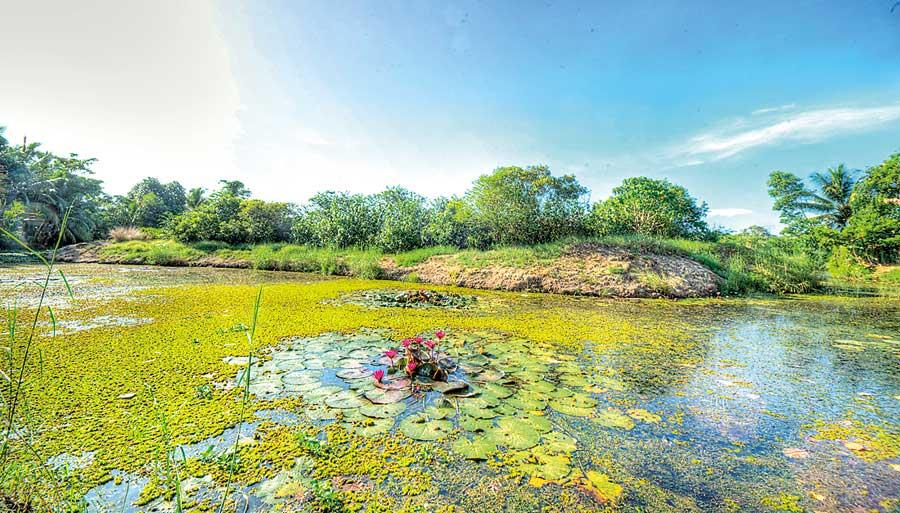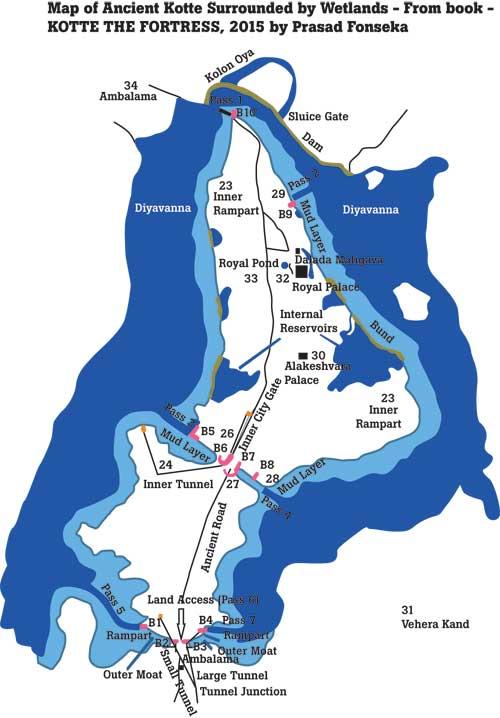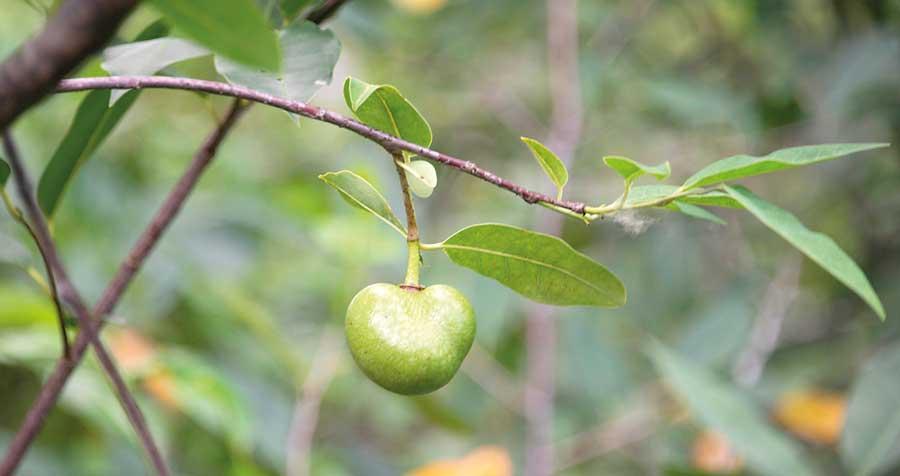01 Jun 2020 - {{hitsCtrl.values.hits}}
When man-made pollution came to a standstill during COVID-19 lockdown the Colombo wetlands attempted to prove a point by displaying all its glory

Nawala wetlands
The Mayan civilization flourished because it emerged right next to a wetland. Taming of Yucatan waters enabled the Mayans to build a city that lasted for more than a thousand years. 
Similarly, Nissanka Alagakkonara, a minister of King Wickramabahu the 3rd, built Kotte fortress right amid Colombo wetlands, not purely because of security concerns but because his loyal citizens preferred agriculture and recreational activities.
The cool “air-conditioning” provided by wetlands might have persuaded King Parakramabahu the 6th to select Sri Jayewardenepura Kotte over Raigama as his kingdom in 1415.
Six centuries later the very same reason made me select the shores of Nawala wetlands as my humble abode. The Kotte area thrives on its lush wetlands for over 700 years since its documented colonization.
"Singapore invested one billion of its currency to build an artificial “Gardens by the bay”. Colombo wetlands could easily be converted to a mega tourist attraction."
Colombo wetlands are shrinking at an alarming rate of 1.2 percent (57 acres) per annum. Even as I write this article, plans are underway to build roads across the historical Nawala-Kotte-Kolonnawa canal marsh endangering the precious fauna and flora of the remainder flood-water reserves.
It is disheartening to see Colombo wetlands being senselessly encroached and destroyed when certain countries like Malaysia have invested more than 20 million US Dollars to build “Constructed Wetlands”.
During the COVID-19 lockdown, certain positive observations were made in the city’s air quality most probably because of the buffering action of wetlands. This article will highlight some of the scientifically proven benefits of Colombo wetlands to its inhabitants.
Colombo was historically built within wetlands. The city’s geography has always been a mix of land and water. The Northern and North-Eastern parts of Colombo are bordered by the Kelani River. Kelani valley civilization backdates to the era of King Kelanithissa (200 BCE).
The floods caused by the Kelani River are thought to have contributed to the marshes of Colombo for centuries. The name ‘Colombo’ is believed to be derived from the name Kolon-Thota. Thota stands for port and hence Colombo might have been a bustling “Port City” even during ancient times. 
The Kotte kingdom especially Ethul Kotte was bordered on all sides by wetlands except for a patch of land that links the fortress to Pitakotte. The name Battaramulla is derived from bat-tota-mulla, a port where the Royal Chefs ferried to collect cooked rice (Bath).
Another port next to Battaramulla was Konthaganthota and both these places were separated from Ethul Kotte by the Diyawanna Oya.
Right at the centre of all these landmarks was the Duwa Island, where the palace of Minister Nissanka Alagakkonara (The founder of Kotte) was situated.
This island was later taken over for the construction of the current parliament building. So mesmerising are the thoughts on the rich history of Colombo wetlands, one could even state that they are more interesting than those from the city of Venice.
The latest studies have confirmed nearly 19 km2 of wetlands extend within the greater Colombo area. Nearly 85% of the water found within this is freshwater and the rest is mostly brackish in quality. Although the wetland network penetrates deep into the land, research has shown that the water levels fluctuate with the sea tides daily.
The habitat has been affected by direct human interference for centuries and through the invasion of alien plant species. Three main types of habitat have been identified. These are termed woodland, herb dominated, and open water. E.g.- The Nawala Kolonnawa wetlands mainly consist of Annona woodlands with an alien invasive plant Annona glabra (Wel atha in Sinhalese) dominating the flora.
Certain critically endemic plants are also seen within the Colombo wetlands. Aganope heptaphylla a tree climber seen in the Kolonnawa marsh is only observed at two other places in Sri Lanka. This is one of the few precious plants from Sri Lanka that are dried and displayed in Royal Kew Gardens, United Kingdom.
For centuries the marshes within the Colombo Metropolitan Region have been claimed, filled, damaged, and sadly lost. Studies show that since the 1980’s areas such as Kolonnawa Marsh have been reduced by as much as a staggering 65%.
Wetlands are a life-sustaining system for the Colombians. The World Health Organisation statements describe that health is not just the mere absence of disease but the presence of physical, mental, and social wellbeing. Colombo wetlands cater to all these aspects of health.
Human beings depend on their lungs for breathing. Other than absorbing oxygen, lungs act as filters, catching and dust and other particles. Similarly, wetlands act as filters and buffers to regulate the air that we breathe.
Any animal requires air, food, and water for survival. Although food and water quality can be assessed and controlled when it comes to inspiring air us townsfolk are left without a choice. This air purification process has now reached its tipping point.
To understand the gravity of this situation we have to understand how population density has increased throughout the past few centuries. The Colombo city population back in 1871 was a mere 98,847 people. The 2012 census revealed a population of a colossal 2,309,809 persons. With the expanding population, we have to expect an increase in the use of cooking fuel, motor vehicles, machinery, and factory emissions.
"Colombo wetlands are shrinking at an alarming rate of 1.2 percent (57 acres) per annum. Even as I write this article, plans are underway to build roads across the historical Nawala-Kotte-Kolonnawa canal marsh endangering the precious fauna and flora of the remainder flood-water reserves"
During the COVID-19 lockdown phase, it was reported that the city air quality improved by leaps and bounds. The reason could be a low number of vehicles, less working population, and factory closure.
The lockdown phase is a good example of how much capable Colombo wetlands are at purifying the air.
Regulation of city air temperature is one essential benefit derived from Colombo wetlands. Climate change and its hazards have been directly affecting our population during recent times and these tiny patches of greenery are fighting a lone battle to control extremes of temperature. The evaporation of wetland water has a direct impact on lowering the city temperature.
Wetlands are a source of food for many city dwellers. The dense shrubs and forests provide numerous types of vegetables and fruit. The land has been used for paddy cultivation for several centuries.
Abandoned paddy fields are spontaneously recaptured by natural forestation. Wetlands also provide ample opportunity for cattle to graze on and are important in milk production. Numerous plants that grow here are used in traditional medicine.

Alien Invasive Plant Annona Glabra - Wel Atha
Low-income urban families receive significant benefits from the wetlands.
The Colombo wetland soils might be one of the largest carbon storages that we have. It is estimated that the marshy land stores over 1.43 metric tons of carbon per annum, chiefly emitted through the combustion of fossil fuels within the Colombo Metropolitan Region.
The marsh is therefore largely responsible for a negative carbon footprint within the province.
Biodiversity within this patch of greenery is vast. About eight endangered and nine endemic species of plants grow here. The total number of plant species seen is well over 250.
The Colombo wetlands are home to more than 20 critical animal species. Many do not know that the fishing cat Prionailurus viverrinus , the purple-faced leaf monkey Semnopithicus vetulus, the Otter Lutra lutra, and Ceylon blue glassy tiger butterfly Idiopsis similis live within the wilderness of the marsh. It’s a birdwatcher’s paradise and if properly developed, could be a research park for ornithology. The insects that breed within the wetlands are responsible for the pollination of plants.
Wetlands provide numerous opportunities for recreational activities. President Gotabaya Rajapaksa during his tenure as the Secretary to the Ministry of Defence and Urban Development understood the importance of this and launched the Colombo Beautification Project.
This initiative uplifted the standards of public centres and parks in Colombo such as Battaramulla Diyatha Uyana, Ape Gama Park, Urban Wetland Park-Nugegoda (Weli Park) which were mostly developed next to wetlands.
Singapore invested one billion of its currency to build an artificial “Gardens by the bay”. Colombo wetlands could easily be converted to a mega tourist attraction.
The great mathematician Archimedes stated that when an object is immersed in water, it experiences an apparent loss in weight that is equal to the weight of the fluid displaced by the object. He reportedly proclaimed “Eureka!” after stepping into a bath and noticing how water spilled over. Similarly, when wetlands are filled by metric tons of soil, the displaced water vanishes through means such as evaporation. Other than the risk of losing precious wetland areas, the sponge action of the marsh during heavy monsoon rains is lost. The ultimate result is the flooding of Colombo city which is sadly no “Eureka!” moment for the “Colombians”. Water-related damage to residencies is also unavoidable. Research suggests that approximately 70 million cubic meters of floodwater are stored within the marshes of Colombo during the rainy season. When 65% of the canal network in Colombo has polluted water the water surrounding the Duwa Island (Parliament) has the cleanest. Therefore wetlands are capable of a water purification action as well.
Development projects that claim wetlands should preferably be avoided or done strictly following the international environmental conservation laws. Even after proper construction, there is ample evidence to suggest that the wetlands adjacent to roads slowly disappear due to reasons such as toxic emissions and noise.
Wetlands are known to act as buffers against noise pollution, but traffic noise itself is harmful to its existence.
Plastic is one of the fastest emerging threats to the environment. I have earlier addressed this issue in my article to Daily Mirror titled “The ever-expanding balloon of plastic”.
Plastic is a breeding haven for mosquitoes and this is known to cause disequilibrium in the balance of insect species. Accidental consumption of plastic by birds and mammals alike causes a slow and painful death. Colombo wetlands is notably a plastic garbage dump for some of its citizens. A method of extracting plastic from the marsh should be designed to prevent further damage.
"Wetlands are a life-sustaining system for the Colombians. The World Health Organization statements describe that health is not just the mere absence of disease but the presence of physical, mental, and social wellbeing. Colombo wetlands cater to all these aspects of health"
Alien invasive plants create a great deal of harm to the flora of wetlands. Species such as Annona glabra, Salvenia molesta and Eichornia crassipes have been identified as intruders within Colombo marshes. Solutions such as the production of compost using these plants or biogas production have been suggested.
It was heartening to listen to remarks made by President Mr Rajapaksa on the “World Wetland Day” ceremony held at Battaramulla “Ape Gama” on the 3rd of February.
He stated the importance of conserving biodiversity in the process of development and how inappropriate development activities have led to environmental degradation and wetlands destruction.
In an era where everyone is very much concerned about the quality of air that we breathe, protecting wetlands is a key priority. When man-made pollution came to a standstill during COVID-19 lockdown the Colombo wetlands attempted to prove a point by displaying all its glory. We should strongly consider giving this lovely patch of greenery a second chance to re-grow and expand.
The writer is a Consultant in Rheumatology and Rehabilitation, Teaching Hospital – Anuradhapura
28 Nov 2024 47 minute ago
28 Nov 2024 3 hours ago
28 Nov 2024 4 hours ago
28 Nov 2024 4 hours ago
28 Nov 2024 5 hours ago